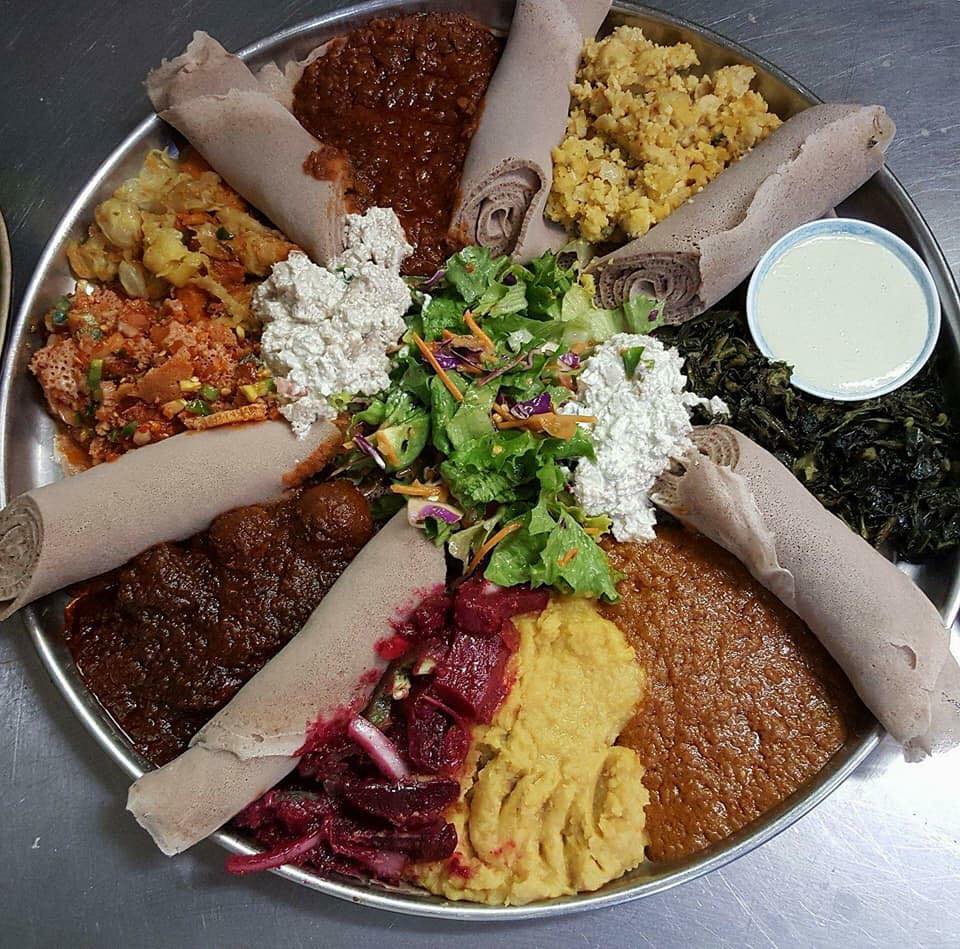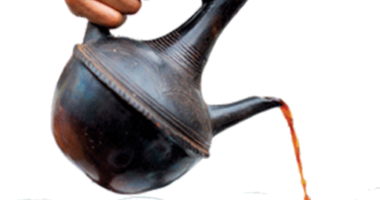The very first thing you need to know about Ethiopian food is something called Injera (Amharic enǧära, እንጀራ). Injera is one of the unique Ethiopian Food. Injera is the staple and the most widely consumed starch/filler in all of Ethiopian cuisine. It is a slightly sour soft fermented flatbread with a slightly spongy texture. Most Ethiopians eat injera twice or even three times a day.
Injera is made from a grain known as teff, which is ground into flour, made into a batter(lite in Amharic), slightly fermented by adding ersho(yeast), and then baked on a circular griddle – either a large black clay plate over a fire or a specialized electric stove. The griddle is known as a mitad (ምጣድ) (in Amharic) into a giant circular pancake where only the bottom gets heat the top is baked by the steam which makes it soft and spongy.
Another Unique thing about Ethiopian Cuisine is that you have to use only your right hand (if right-handed) or left hand (if left-handed) but you are encouraged to use your right hand. Ethiopians eat with a big plate (teri) so that they share their food. There is a culture where give a “Gursha” to your family member, relatives, close friends, and any people that you want to show your love and respect.
If you are vegan then Ethiopian food is made for you. Ethiopian Cuisine is a very Vegetarian-Friendly Cuisine where you find delicious, well-seasoned, and healthy food. Ethiopians often eat vegan food because every Wednesday and Friday, Christmas, “Fasika”, “Yesene Tsom”, as well as during the lent period each year and many other durations for those who follow the Ethiopian Orthodox faith, is known as fasting days. Now, this doesn’t mean not eating, it just means not eating anything that comes from an animal, or in other words only vegan food.

5 Most Popular Vegan Breakfasts are Injera fir fir, Fit fit, Fatira, Kinche and Fuul.
- Fir-fir is prepared with a combination of berbere spices, onions, tomatoes, garlic, ginger, vegetable oil, and torn pieces of injera. It is sometimes served for breakfast with yogurt and chili peppers on the side. When chunks of meat are added to the fir fir it is called sega fir fir. When the injera we use is dry injera it is called derkosh fir fir. If served in a bowl, injera fit-fit is consumed with a spoon, but when it’s served on top of another piece of injera flat, it is customarily consumed with the right hand.
- Fit fit is simple food and delicious food to prepare. All you have to do is add torn pieces of injera to a leftover hot stew and mix it up. then serve with some slices of chili to bring the freshens of the food.
- Fatira is a traditional Ethiopian street food item that is commonly consumed for breakfast, consisting of a large, crispy, wheat flour pancake that is made only from flour, salt, and water. It is served with scrambled eggs, honey, or both and tea. Fatira is often cut into smaller pieces, and it is especially popular during Eid-al-Fitr.
- Simple, nutritious, kinche is an Ethiopian breakfast staple made with cracked wheat that is boiled in water. The best way to describe kinche would be as the Ethiopian equivalent of oatmeal. After it has been cooked, kinche is added to the pan with either oil or clarified butter known as niter qibe and fried onions, although kinche can also be consumed without any flavorings.
- Fuul is a nutritious food that can make you last for a long duration. It is prepared of onions, garlic, cooked beans, tomato sauce, ginger and the ethiopian flavor berbere spice. It is served with bread and may also be served with youghurt,spambled egg.
Popular Non-Vegan Breakfast are Genfo and Chechebesa
- Genfo is a simple Ethiopian porridge that is commonly consumed for breakfast, made by adding dry-roasted barley flour to boiling water and stirring the concoction with a wooden utensil until it develops a smooth, yet extremely thick consistency. The porridge is then transferred to a bowl, and a well is created in the center. The well is filled with clarified spiced butter and berbere spices. Genfo is traditionally consumed as it is, although it can be accompanied by a scoop of yogurt. The dish is often shared and consumed by pulling the thick porridge pieces from the outside and dipping them into the spice blend in the center.
- Chechebesa (Kita fir-fir) prepared with a combination of torn pieces of Kita flatbread, clarified butter, and berbere spices. The dish is traditionally served for breakfast when it’s accompanied by plain yogurt. Unlike most Ethiopian dishes, Kita fit-fit is typically consumed with a spoon instead of using the right hand.

Most Popular Vegan Lunches are Shiro wat and Beyainatu
- Shiro wat is a very popular and affordable food in ethiopia.It is prepared with the combination of onion, tomato, berbere spices, garlic, ginger and shiro powder. It is often eaten when it is hot.It is often served with salad.
- Beyainatu is a variety of food on one dish. It is a food that a lots of stew and many types of salad is served on a single plate.
5 Most Popular Non-Vegan Lunches are Doro wat, Kitfo, Tibs, Tere Sega and Dulet
- Doro Wat is the most popular food in ethiopia.It is prepared for special occasions such as holiday, wedding, graduation, family union and the like.The key to authentic, great-tasting Doro Wat is good quality, flavorful berbere, and a very long cooking process. It can take several hours for an Ethiopian to make Doro Wat. You can cut back on the cooking time and your Doro Wat will still taste good, but it won’t taste like it’s supposed to. The magic is in the slow-cooked onions. It takes time for the magic to happen.
- Kitfo, a dish made from raw minced beef,butter and ethiopian species mitmita.It is one of the most beloved local dishes in the entire country. It’s a food that’s often eaten on special occasions, with good friends or family.
- Tibs is a simple and delicious to eat with injera or by itself.It is a fried meat with onion and butter or oil.This food is often enjoyed in most restaurants and very available.
- Tere Sega is simply cubes of raw meat. Two people typically order half a kilo to share. You will be given a piece of meat then you slice it as you want and eat with either “Mitmita” or “Awaze” a mixture of berbere,oil,water and salt.
- Dulet is an Ethiopian combination of beef,liver and lamb tripes. It is prepared with onion and mixed well and cooked until the fluid in the meat is dried. It is delicious and a food to eat non stop.









